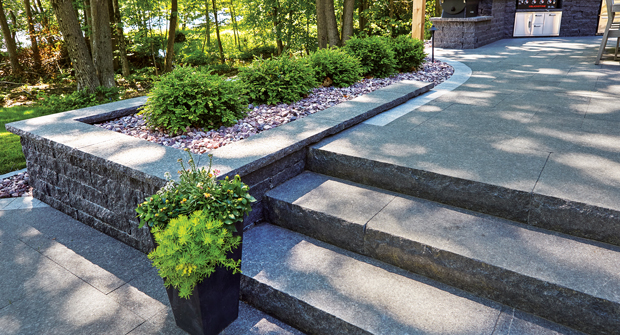Spring has finally arrived. The smell of baby back ribs wafting off the smoker on a Saturday afternoon — does it get any better?
Actually … it could. As far as the baby back ribs rub, well, it depends on the recipe; we’re willing to try anything. But for some homeowners, a sticking point is why is the smoker sinking into muddy ground?
Matt Freedman, president of Beach Landscaping in Myrtle Beach, S.C., says many of his clients are folks traveling south to escape the cold weather up north. They’re buying tract homes, and those come with 10-foot-by-10-foot concrete pads — not nearly enough room for a comfortable outdoor cooking scenario.
“A 10-by-10 concrete pad isn’t enough to fit a table, four chairs and a grill,” Freedman says. “The requests we’re getting is adding on to an existing patio and creating a greater area for them to grill and enjoy the day and the weather.”
Freedman says his clients are most interested in darker colors — browns and grays — when it comes to paver selections. They’re also interested in larger pavers versus the smaller formats.
Landscape Management spoke with three additional paver experts to learn what the market looks like around the country.
Bigger, but not smoother
Jason Chilson works for Wisconsin-based Kafka Granite; he’s a regional sales representative for the company. He’s been with Kafka for eight years, first selling locally in Wisconsin, and now he covers all of the Midwest.
Chilson says in his region, earth tones are picking up steam, but starlight black and imperial gray are still the strongest sellers. He is confident the market is strong going into 2025 and is especially bullish on the company’s granite products.
“The first thing I always think about is the durability of the granite material versus some other stone products on the market,” Chilson says. “(Granite) has a better surface … it’s not as porous. It’s very low absorption, very high compressive strength. The other thing is the look of the material is much different. It has a higher level of finish. The grain, the texture, has a reflective finish.”
Joe Raboine, vice president of design at Oldcastle APG, a parent company of Belgard, was at the International Builders’ show in Las Vegas with 81,000 colleagues when Landscape Management caught up with him. He’s been with Oldcastle for 12 years and was a vendor for five years before that.
Raboine agrees that warmer tones are becoming more popular but adds that gray still accounts for 70 percent of Belgard’s sales. The biggest trend in pavers, in his opinion, is the use of a larger format of paver, something that started in Europe 10 years ago.
“The consumer wants a cleaner look — but that doesn’t necessarily translate to smooth pavers,” he says. “People are very interested in texture. Basalt, for instance, has kind of a flame-finished model. Texture is very popular. We have a paver called papyrus that has an almost organic effect, kind of ‘tooled,’ almost like clay.”
Sustainable solutions
Connor Ouwinga is the national sales manager for Porous Pave, a recyclable permeable pavement. The product has been available to the market for 18 years now. Ouwinga says a trend he’s seeing is the customer’s desire to be environmentally friendly. Porous Pave’s material is made from recycled tires, something that resonates with its clients.
“Over almost 20 years, we’ve recycled over 25 million pounds of tires,” Ouwinga says. “That’s pretty incredible, keeping that material out of the landfill and using it for a variety of different applications.”
Ouwinga says he wants contractors to think of Porous Pave as a unique alternative to a traditional paver. That’s because the product is paved in place and, therefore, more cost-effective than a standard brick paver, he says.
“It’s easier for contractors to work with,” he says. “It’s also quicker and more cost-effective. It’s flexible. I live in Michigan; freeze/thaw is always a concern for pavers and different types of pavements being jacked up during the freeze/thaw. Our product isn’t affected by that; it’s very permeable.”
Pondering pavers
Freedman is an authorized Belgard installer, but he also considers other options if the client wants to see alternatives. He says business is booming in the Myrtle Beach area, and he expects to have a full slate of design/build work for his crews in 2025
But has the job of installing pavers gotten any easier?
“We have the tools. Excavating machines, for example. But on a lot of these houses, there isn’t enough room to use a machine, so we do a lot of manual digging,” he says. “So, the answer to the question is no, it hasn’t gotten any easier.”


